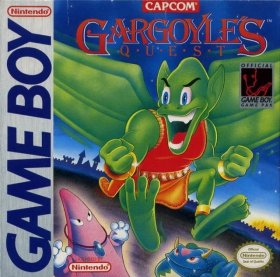
Game Over: Gargoyle’s Quest
Recently, thanks to Nintendo Switch Online and definitely not any other sort of means of playing older games, I’ve been giving some titles for the original Game Boy a shot. One of those was Gargoyle's Quest, a Capcom spin-off from the Ghosts ‘n Goblins series that sees you playing as the series-regular enemy, Firebrand, a sort of red-winged creature that swoops in to attack that series’ protagonist. Here, he fights to protect the Ghoul Realm and save his people from destruction.

Now, I know I was making a bit of a joke at the start by ignoring things like unofficial emulators, but I do genuinely appreciate NSO in this instance. I hadn’t had much of an interest in the Game Boy as a source for games to enjoy and, as such, had never looked into ROMs for it. However, since I had access to NSO, I decided I might as well give the titles it includes a shot, starting with the Game Boy library, seeing as it was the smallest of the three default game libraries and because one of those games was Alleyway, a Breakout clone and thereby automatically an amazing title (but more on that one another time, perhaps). Due to this, I tried a bit of the handheld console’s selection, actually giving some classics a proper chance.
In the case of Gargoyle’s Quest, I likely never would have sought it out otherwise. I’d played the original Ghosts ‘n Goblins before, but it honestly didn’t click with me and I didn’t play through it more than once. Why then, would I be interested in a spin-off on a console I don’t super care about? However, once I did actually give this game a shot… I found that it was a decently enjoyable experience that I’m glad I had, even if I won’t play it again.
Gargoyle’s Quest, it turns out, is a little bit like Zelda II: The Adventure of Link, with it being split into two gameplay styles. When out of combat, Firebrand is seen from a top-down perspective where he can explore towns, talk to people, find items, and walk around open areas to be ambushed by random encounters. When getting into combat, he enters a side-scrolling view where he can jump, glide temporarily, and shoot bursts from his mouth that are probably flames.

Firebrand starts off pretty weak, and you have to jump him around to dodge enemies and try to find safe places to pick them off from afar, but as the game goes on, he gains upgrades to his various stats, letting him take more hits, jump higher, and glide for longer. By the end of the game, he can even glide endlessly, which feels very cool and powerful. He can also unlock different breath attacks. His default is weak and the last attack is easily the strongest and the best tool to take care of enemies, but the middle two both deal decent damage and have additional effects. One of them can break special blocks and the other can splat against hazardous spikes and make them safe to climb for Firebrand. It’s a tad annoying to flip between these attacks on the fly in the few levels that demand you do so repeatedly, but it doesn’t take too long.
Overall, moving around as Firebrand can be incredibly fun and I loved jumping and gliding around as much as possible. However, fighting enemies was sadly not quite as fun. Many encounters mostly involved just trying to get into a boring rhythm of getting into their face, blasting them a couple of times, and moving back out. There was hardly any satisfaction in the fights themselves, partly because the enemies moved rather predictably and partly because it was impossible to see how much damage I was doing (and in some cases, even if I was doing damage in the first place). There were some interesting mechanics here and there, but on the whole, it was a bit middling.
The plot, however, was fun, even if that was mostly because of the novel idea of taking this villain’s perspective and seeing in what situation he would be seen as a hero. There’s some details here about Firebrand being a destined hero of sorts and he has to save some powerful figures a few times, but the story holds together okay and the novelty helps to keep it afloat for its short playtime.

In retrospect, I admit I am being a bit harsh to this decades-old game, but I do want to stress that I did have fun with this! It was a bit clunky and not always the best to look at, but playing this on emulation really minimised a lot of the frustration that I might have otherwise felt and its sheer uniqueness helped to amplify its many charms. Movement can be very fun and gosh darn it, the ending music is also so sweet to listen to when everything is said and done. I am pleased to have played this all the way through and interested in possibly giving more in this spin-off series a chance, even if I don’t intend to revisit this particular entry.








COMMENTS